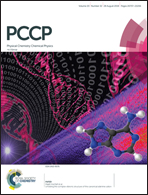Electron transfer vs. proton-coupled electron transfer as the mechanism of reaction between amino acids and triplet-excited benzophenones revealed by time-resolved CIDNP†
Abstract
Hyperfine coupling constants (HFCCs) of the short-lived radicals of 4-carboxy, 4,4′-dicarboxy, and 3,3′,4,4′-tetracarboxy benzophenones (4-CBP, DCBP, and TCBP, respectively) formed in their photoreaction with tyrosine were obtained from analysis of geminate CIDNP spectra. These HFCCs were compared to HFCCs calculated using density functional theory. From this comparison, it was established that the CIDNP pattern of TCBP originates from contributions of three types of TCBP radical structures: the non-protonated anion radical and two anion radical structures with a protonated carboxylic group at position 3 or 4 (or 3′ or 4′). This allowed us to conclude that the mechanism of the quenching reaction is proton coupled electron transfer (PCET): electron transfer is followed by proton transfer to one of four possible positions with similar probabilities. The same CIDNP pattern and therefore the same reaction mechanism was established for histidine. For 4-CBP and DCBP, triplet quenching proceeds also via PCET, again with formation of the anion radical with a protonated carboxylic group.



 Please wait while we load your content...
Please wait while we load your content...